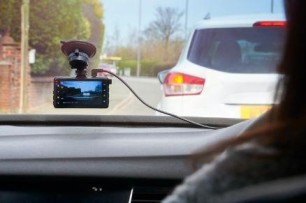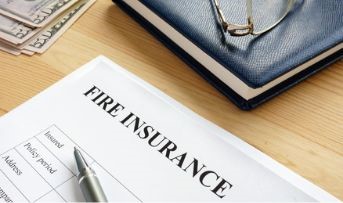General Insurance Blogs, Articles & Updates by - Magma HDI
Have us call you
- RENEW YOUR POLICY
- BUY NEW POLICY

Let's understand why dashcams play a vital role while driving a car
We all know the challenges of driving these days, no matter where we drive. The roads are raided with potholes, many drivers do not follow traffic regulations, and the unmaintained roadways are challenging to manoeuvre. While evading stray animals, pedestrians, or even rash drivers, we often come too close to getting into serious accidents. As per a report, over 4.37 lakh accidents occurred on Indian roads in 2019. Clearly, even after years of experience in driving and having a focused mind, several people in the country still get into unfortunate crashes that ruin their lives and the lives of their loved ones.
While you can take several precautions during driving, you can also install safety devices that help enhance your degree of protection. Using a dashcam while driving can play a vital role in providing security on the road. Let's understand how.
What is a dashcam?
A dashcam or a dashboard camera is like any other compact camera designed to give the car's occupants a clear view of the road ahead. The camera is positioned on the windscreen to record the road ahead and placed on the back of some vehicles to record the rearview. This camera starts recording as soon as you start the car or push a button.
The driver can view all the movements and incidents happening not only on the road ahead but also behind on a monitor installed inside the car. You can view the proximity of the vehicles around you, giving you a better edge at driving.
As a great convenience, the recordings on the dashcam can be saved on an SD card. You can access this footage as proof material in case of accidents.
What are the benefits of using a dashcam while driving your car?
No matter how many years of driving experience you have, you will never know when a dangerous accident might occur. Drinking and other destructive behaviours behind the wheel are vastly known to take innocent lives. Besides the fatalities and injuries, several vehicle damages and monetary losses are also incurred. A dashboard camera can help in several such situations:
1. A dashcam can assist the police in punishing the offenders in accidents by providing viable evidence. They can access the footage from the dashcam to view the factual occurrences rather than basing a case on mere statements.
2. A dashcam can be highly cost-effective. It can prevent the daily wear and tear that your vehicle might suffer from on the road by giving you a well-rounded view while driving, taking turns, and parking.
3. If you want to buy new car insurance, look for plans that offer a discount for installing a dashcam. Insurance companies recognise the benefits of this device. They sometimes provide a hefty discount on your premium if your vehicle is equipped with one and if you ensure other safety measures too.
4. Dashboard cameras are highly effective in promoting safe driving. They allow you to keep an eye on the rearview and side mirrors and foresee crashes or bumps.
The dashcam is proven to play an essential role in securing your personal as well as your vehicle's safety. There is a wide variety of dashcams available in the market. Invest in a good quality one to safeguard your future and ensure a quality driving experience. Remember, dashcam provides you advantages like lower premiums when you buy new car insurance as it can assist with settling claims quickly.
Click HERE to buy new car insurance for the additional safety of your car.
Disclaimer: The information provided above is for illustrative purposes only. To get more details, please refer to policy wordings and prospectus before purchasing a policy.

Here's all you need to know about Roadside Assistance and understand its importance
It can be daunting to have your car breakdown in the middle of nowhere, even worse if it's raining or pitch-black outside. Roadside assistance is a lifesaver in such situations and something you should consider while investing in a car insurance policy.
Every car owner in India is required to have insurance. The critical piece of paper in your car's dashboard keeps you from getting a ticket and helps you arrange your finances. You can also buy car insurance online to protect yourself from financial stress in such situations.
That's not all, though. Car insurance add-ons protect you from the high costs of repairs and maintenance. One such add-on is roadside assistance.
Let's talk about this cover and why it's so important.
What is Roadside Assistance?
Roadside assistance (RSA) is an optional coverage that helps you when your car breaks down. Some motor insurance companies include this protection as a standard feature, whereas others provide it as an optional add-on that the car owner can choose to purchase. RSA coverage does not count as a claim on your primary insurance policy if you need quick assistance.
How does RSA work?
Call your car insurance company for assistance, and a crew will arrive at your location in no time. Almost all services are free, but you may have to pay a fee in some cases. For example, if your vehicle needs to be towed, you will have to pay for it. Some companies also offer taxi services to your next destination.
What benefits does RSA offer?
The roadside assistance feature covers a wide range of circumstances, including the following:
1. Suppose you face a flat tyre issue. In this case, a mechanic will trace your location and arrive at the spot. The mechanic will inspect the situation and replace the flat tyre. If needed, your car might be towed to the nearest garage for better servicing. It saves you from looking for towing vans or garages to fix your vehicle.
2. Your car's battery might drain. Here, a mechanic will arrive on a call and assist you in jump-starting your vehicle and bringing it back on the road. This is one of the best benefits offered by RSA insurance, especially when you're travelling alone.
3. Suddenly running out of fuel can bring an annoying situation to you. However, the RSA insurance policy allows you to request 5 litres of fuel to reload your tank without any hindrance.
4. RSA covers breakdowns that require minor repairs on site.
5. If you lose your keys while on vacation, the insurer will help you get a new set of keys if you're within the reach of an approved limit of Kms.
6. The insurance company will arrange for immediate and safe towing to a nearby garage or authorised automobile centre in case of an accident.
Typically, roadside assistance services come with a different premium, depending on the plans chosen, the number of services required, and the size of the geographical area covered. Having a roadside assistance add-on can save you significant money in service fees. So, buy car insurance online today to safeguard your car and yourself in emergencies and ensure the best coverage for your possession.
Click HERE to know more about car insurance online!
Disclaimer: The information provided above is for illustrative purposes only. To get more details, please refer to policy wordings and prospectus before purchasing a policy.

Here is how you can protect yourself from the extreme summer heat
With those delicious ice creams and mangoes, the warm summer months can provide a lot of joy! However, it's that time of year again, when we sweat through our pores and anxiously wait for the rains to come. Even for the most experienced of us, summer in India can be harsh, with increasing global warming and climate change contributing to it. It can be hazardous by increasing the risk of heatstroke, in addition to making us feel exhausted and sapped.
It is usually best to spend most of your time indoors if the temperatures are too high outside. However, this is not possible all the time. As a result, being well-prepared for the summer heat is the best approach to protect ourselves from it. While there are some precautions to avoid falling sick in the extreme summer heat, a health insurance plan is always noteworthy protection against any health ailment.
So, here's a list of some of the most simple and effective ways to protect yourself against the harmful effects of severe heat on your body.
1. Dress light:
Light, comfortable clothing is one of the most effective approaches to beat the summer heat when you're outside. Stick to lighter colours and breathable textiles like cotton. It will not only keep you cool and comfortable, but it will also prevent skin infections and irritations caused by skin-to-fabric friction. On the other hand, wearing dark-coloured clothing, such as black or brown, absorbs the sun’s rays, making you feel more burning than usual.
2. Rehydrate:
To compensate for the fluids lost from sweating, you need to drink plenty of water. Don't wait till you are thirsty, as it is not always a direct indication that your body requires more water. When exercising, tiny sips of liquid are preferable. The most excellent solution to restore lost fluids is water. If you sweat a lot, use water with salt added to it. You may also drink fresh fruit juices to keep yourself energetic, active, and fresh during the retiring summer days.
3. Eye gears:
Excessive exposure to the sun might harm the eyes permanently. One of the most common causes of unpleasant headaches is exposure to intense sunlight. Wear a good pair of sunglasses that give UV protection to safeguard your eyes and vision. If you use prescription glasses, you should look for lenses with an additional layer of UV protection. Also, after a long and exhausting day in the sun, applying an active cooling gel eye mask can provide significant comfort to your eyes.
4. Light diet:
Always choose a light diet over a heavy one. Fried and fatty foods impede the digestive system, negatively impacting general health. During the summer, stick to soft foods, particularly raw vegetables. Avoid alcoholic beverages, tea and coffee, which can promote dehydration. Tea and coffee inhibit the functioning of antidiuretic hormones, making you go to pee frequently.
5. Prevent skin damage:
It's impossible to overemphasise the need of wearing sunscreen, especially on hot days. Choose a sunscreen with an SPF of 15 or higher appropriate for your skin type. Apply it for at least 30 minutes before going out into the sun. Try to wear full-sleeved clothes to avoid direct contact of your skin with the sun’s rays.
With its longer days, lovely blossoms, and evening breeze, summer comes with its own set of experiences, which we cannot avoid. We must be particularly cautious about our health and ensure that the heat does not suffocate us. The steps outlined here are for prevention and should be added with extra protection by the best health insurance if things don't go as planned. Stay safe this summer.
Click HERE to know more about health insurance!
Disclaimer: The information provided above is for illustrative purposes only. To get more details, please refer to policy wordings and prospectus before purchasing a policy.

Here are a few things you need to know before considering a hair transplant
People implemented many natural techniques to strengthen and maintain luscious and smooth hair in olden times. With the advancement of technology, many new factors came into the picture regarding hair care. Pollution, improper nutrition, and a hectic lifestyle are some of the main constituents determining your hair's health. But these elements might not be the only reason you might experience hair issues.
A lot of people complain about severe hair fall, receding hairlines, thinning of hair, split ends, etc. These are painful issues faced by people of all age groups and genders. And while medicines and specific treatments might work for some, that is not a feasible solution for everyone.
A lot of people think about going for a hair transplant. But before taking that step, you need to be aware of what to expect from the procedure.
Here are a few things you need to know if you consider a hair transplant.
1. Categorize yourself:
It's crucial to check all the boxes regarding eligibility to get started with the procedure. Though this procedure is not extensively invasive, the doctor needs to inspect the type and pattern of your hair, baldness, your health parameters, donor availability and quality. Make sure that you have realistic expectations regarding the results of this process.
2. Precautions to be taken:
There are several things you'll need to consider before beginning the process. These include the cost, results, and the products you'll need to use afterwards. Your doctor will give you a complete rundown of the procedure and the precautions you'll have to take beforehand.
3. Recovery:
Your scalp might feel tender or swollen after the procedure, in which case, the doctor might prescribe specific dietary instructions and medicines. Antibiotics and anti-inflammatories medicines may help reduce your scalp issues and avoid infections. Zinc, iron and B-complex vitamins promote hair growth, so you must ensure to make them a part of your diet.
4. Research about the clinic:
It is essential to ensure that the clinic you'll be going to and the doctors performing the surgery are experienced and well-equipped. Many patients have terrible experiences after getting lured in with huge discounts and low prices and having their treatment done by less qualified doctors.
5. Types of transplants:
There are several hair transplant procedures you must know about. Follicular Unit Extraction (FUE) is a process in which the surgeon clears the donor area of your head and then extracts hair follicles individually with a microneedle.
The next type is Follicular Unit Transplantation (FUT), in which the hair dissects a long strip of scalp from the donor area into 500-2000 follicles. These follicles are then placed into tiny cuts made in the recipient area.
Direct Hair Implantation (DHI) is a smoother process in which an implanter is used to implant hair into the recipient area from the donor portion of your scalp.
These are a few things you should know before taking up a hair transplant. And while we are discussing health conditions that might lead to severe hair loss, you also need to think about your wellbeing and ensure your protection against other health ailments.
Health is unpredictable and can drain your pockets heavily under certain circumstances. We recommend you cover your health with an ideal insurance plan, and rest assured. A wise option would be to purchase online health insurance, which would cater to your needs and take care of your expenses. You can explore multiple deals online, but carefully go through all the details, terms and conditions and then purchase a policy that offers the maximum benefits.
Click HERE to know more about how you can buy online health insurance.
Disclaimer: The information provided above is for illustrative purposes only. To get more details, please refer to policy wordings and prospectus before purchasing a policy.

Here are a few tips and tricks to enhance your calligraphy skills
Clear text and handwriting create a good impression on the person reading what you have written. While improving your handwriting was mandatory during school days, many people have taken this up to a higher level and started learning calligraphy recently.
Calligraphy is a type of art where you design and execute the writing elegantly. It is an ancient art form that is now making a huge comeback and gaining massive popularity. You can use a pen, ink or other writing instruments to practice calligraphy. Many people have structured their small businesses around drafting wedding cards, greeting cards, frames, posters, etc., in beautiful calligraphic styles.
Are you interested in calligraphy and want to improve your art? Here are a few tips and tricks to enhance your skills.
1. Draw your letters:
Do not consider calligraphy as writing sentences. Think of the words individually. Visualise what your whole sentence would look like and how it would make you feel. Structure that in your head, and then draw the letters beautifully. Make them interesting.
2. Which pens to use:
Before practising your strokes and letters, you need to understand the type of pens and nibs you would have to work with to attain a specific style. It would be best to opt for tools that suit your expertise. A beginner shouldn’t use the most traditional and expert-level tools and stress themselves.
Modern calligraphy gives you the liberty of starting with a pencil or a ballpoint pen. Once you move past the initial levels, experiment with different nibs, pens, and the intricacies that would come along and the strokes that would go with them.
3. Choosing the suitable sheets is important:
Try to look for the proper practice sheets that suit your skill level. You can either go for the sheets, which would help you practice tracing the letters or practice using reference sheets where you have to independently try and copy the style of the letters on a blank sheet. Many sheets have a base, a certain height and letters you can trace and draw for practice.
4. Be careful about spacing:
You need to ensure that the words and letters have equal spaces between them. Regular practice will help ensure consistency in writing. Dedicate time to writing and give special attention to the spacing between the letters.
5. What about the writing angle:
Find patterns in the script you are using as a reference. Using the correct writing angles helps you achieve a specific lettering style and pattern. (The angle here is the angle that you are writing at)
Many practice sheets come with a reference or an information box regarding the writing angle. Read the information carefully and accordingly implement it while writing.
6. Begin with modern calligraphy:
Modern calligraphy (also known as faux calligraphy) is easier to start with. There is no usage of traditional tools, and you can start with as simple a tool as a pen.
You don’t have to deal with the daunting tasks of understanding dip pen brushes, multiple strokes created by applying different pressure levels, etc. Faux calligraphy takes a more practical approach.
That’s a wrap on a few tips and tricks to enhance your calligraphy! Did you know that the art form of calligraphy helps improve your mental health? It is considered to be therapeutic and relaxing. Daily busy schedules and hectic routine life can take a toll on your mental and physical health. Indulging yourself in activities like calligraphy can do wonders.
Health is unpredictable, making it crucial to safeguard it with insurance to smoothly deal with unfortunate health emergencies. You should never compromise with your health. Therefore, select the policy that comes with the best coverage and long-term benefits. Explore your options and then purchase the best health insurance policy in India.
Click HERE to know more about buying the best health insurance policy in India.
Disclaimer: The information provided above is for illustrative purposes only. To get more details, please refer to policy wordings and prospectus before purchasing a policy.

Find these exciting tips to get cheap domestic flight tickets for a budget-friendly trip
We usually hear that last-moment plans are the most exciting ones. But, they come with their challenges. Making these plans and executing them are two different things. Either you compromise on your destination or pay extra for airfare, hotel stay, etc.
We always end up figuring out ways in which we can reduce the overall expense during the course of our travel and finding cheap alternatives to the otherwise exorbitant pricing of the peak season chaos.
This article will discuss a few tips and tricks that you can use to book cheap tickets for your next vacation and spend those extra bucks on good food and shopping
1. Picking the right time:
This is the simplest way to save some money on flight tickets. Booking way ahead of your actual travelling date ensures that you get the cheapest option. A common trend is to book your tickets anywhere between fifty to sixty days before your trip.
The closer you are to the travelling dates, the higher are the prices. The fares are generally the highest during the last two weeks before the flight.
2. Be flexible with your timings:
Airlines generally tend to charge less for early morning or late-night flights. Although it can be a little uncomfortable, you can see a reduction of up to twenty per cent from the actual prices when you make a booking for the wee hours.
3. Clear your cookies:
Based on your internet search history, airfares increase if a particular commute route is repeated often. Clear all cookies from your browser. Another alternative is to use the incognito mode.
4. Opt for low budget airlines:
Low-cost airlines aim to attract more passengers by significantly reducing their fares. However, choosing a low-cost airline means you will need to compromise on other aspects such as legroom, food onboard, etc. But this is a foolproof way of finding cheap tickets even at the last moment.
5. Use multiple websites:
Surfing through various websites to figure out the lowest fare is another easy way of securing cheap tickets. Sometimes, websites fail to share all the flight options on a particular day. Hence, it is good to look through at least 3 to 4 websites to get the best prices and deals.
6. Use alternative routes:
Booking direct flights can be expensive but hopping flights can save thousands on the ticket. If you're flexible with your timings and routes, hopping flights are the best to offer you cheaper flight options.
7. Use debit and credit card offers:
Various special offers are always running on your cards throughout the year. You can get reduced fares and cashback by using these cards while purchasing your tickets. To look for offers associated with your card, you can directly go to the website or do a quick google search.
These are a few tricks that will help you find cheaper airline tickets. Remember that cheap tickets can also mean compromising on other aspects of your travel. There might be hidden costs, baggage restrictions, inconvenient departures, or a luggage mixup.
Before you set out on your trip, you must buy general insurance. This will act as a safety net if you face any issues during your trip. Buy general insurance online to avoid the last-minute chaos and get the financial protection and other benefits to make your trip more enjoyable!
Click HERE to buy general insurance online.
Disclaimer: The information provided above is for illustrative purposes only. To get more details, please refer to policy wordings and prospectus before purchasing a policy.

Five things to take care of before setting off on a desert safari
Do you plan your next holiday break enjoying the enthralling desert safari? If yes, then your vacation will inevitably be more remarkable than you could have imagined. Losing oneself in a unique sandy landscape is a captivating experience.
Though an ordinary day in desert safari is loaded with daring energy, there are numerous opportunities for a prosperous evening to add fascinating experiences to your vacation. However, it can also be annoying to overlook a few travel essentials.
Therefore, here are a few things to take care of before starting your desert safari journey.
1. Consume a modest diet:
We highly advise you to have a light meal at least an hour before you depart. Nothing too greasy or hot. A desert ride, particularly dune-bashing, may be rough, and you wouldn’t want to land up with stomach problems arising midway.
2. Get in the perfect state of mind:
Although a journey to the desert is often exciting and adrenaline-pumping, it may also be tricky at times. Make sure that you are both emotionally and physically fit for the event. Bring a positive attitude, a spirit of adventure, and maybe a little bit of determination, and you are good to go!
3. Do not carry extra clothing:
Bringing a lot of clothing on a desert safari may seem to be okay, but it is not. Your desert safari excursion includes a lot of walking and moving. Walking with too much or heavy luggage is intricate and can be tiring. So, it’s best to pack a few light clothes and a pair of easy-to-wear shoes.
4. Pack nothing unnecessary:
Many individuals carry unnecessary items with them that they will never use. Consequently, the additional weight and space make it difficult to enjoy the safari thoroughly. Just pack the things that can be useful during emergencies, like your medications, water bottles, etc. Stocking water bottles is essential while on a desert safari due to the excessive sweating that may make you dehydrated. Consume liquid intake at regular intervals and carry food packets to keep you energetic throughout the safari.
It would be better if you also kept bandages and aspirin in your hand luggage. Don’t forget sunscreen and other desert essentials like a hat, sunglasses, etc.
5. Consider your instructor’s suggestions:
You must never disregard the directions provided to you because there is nothing more important than your safety. Sand bashing can be dangerous if the golden rules of dunes are not followed. So, unless you are physically prepared to participate in it and other outdoor adventures, we recommend that you play it as cautiously as possible.
While you are entirely ready for your desert safari tour, spending time in the desert is not that simple but not too challenging either. With the proper guidelines and advice, you will be just fine to capture the best moments traversing through the desert and experiencing some sun, sand, and fun.
Desert safari is an enticing activity that everyone should take at least once in their lifetime. Research the best places to do it and put this on your bucket list. Similarly, do your research on insurance and get the best general insurance for yourself before leaving for the trip. General insurance can add a layer of safety to your travel plans and ensure compensation even if you face any damage or loss during your trip.
Click HERE to buy general insurance.
Disclaimer: The information provided above is for illustrative purposes only. To get more details, please refer to policy wordings and prospectus before purchasing a policy.

Fire insurance inclusions and types that you must know
Buying a high-value fixed asset like land or property is always expensive and risky, whether commercial or residential. Several external factors are outside the control of property owners, including fire, burglary, etc., which may result in extreme losses.
Purchasing insurance against such uncertainties is a prudent mechanism. It ensures that the amount of damages or loss is covered by the insurer, which is why buying fire insurance for any property you own is essential. Irrespective of whether you buy an insurance policy online or through an offline agent, you must be aware of what fire insurance covers, its inclusions, and various types to help you make the right choice.
Read on to learn all about fire insurance inclusions and types.
What is fire insurance?
Fire insurance is a contract that protects the insured against financial losses arising from damages or loss to his property or assets. Usually, it is purchased as a supplementary cover having several inclusions apart from just fires.
Essential features of fire insurance.
● It is purchased for one year
● It covers property, heavy machinery, stock of goods, furniture and fittings, etc
● The insurer can settle a claim on actual cash value or replacement cost basis
● It only covers direct loss to the insured property, making consequential loss claims non-admissible. However, add-on covers for the same are available at an additional cost
Inclusions of fire insurance.
As stated above, fire insurance covers unintentional risks beyond the scope of just fires. These include:
1. Fire:
The most apparent risk insured against is the fire itself. It has a broad range of inclusions and covers all fire-allied accidents, making the policy highly beneficial to business premises that regularly deal with fire.
2. Lightning:
Damages or losses caused by fire or lightning are within the scope of the policy. This may include cracks that run down the buildings or roof coverings, etc.
3. Explosion:
Blasts caused by high temperatures or high-pressure gases are included under the policy. However, read the fine print before you buy an insurance policy online. Many insurers make slight changes in their offerings and may not cover damages due to centrifugal force-based machines.
4. Aircraft damages:
Any fires caused due to an aircraft or an airborne device, including the dripping of explosive cargo, crashing, etc., are policy inclusions.
5. Violent activities:
These include a broad spectrum of terrorist activities, strikes, riots, or any public violence actions that may damage or set fire to the insured property.
6. Natural calamities:
Natural calamities are beyond the scope of the control of humans and include storms, typhoons, landslides, rockslides, floods, etc.
Types of policies.
The maximum claim amount that you can raise is based on the type of policy purchased.
1. Valued policy:
In this case, the contract states a pre-decided amount to be paid by the insurer in case of damage or destruction. This amount is non-alterable post-fire, and such a policy ensures high-value personal effects.
2. Specific policy:
This type of insurance is purchased where the insurer is liable to pay either the specified amount or the actual loss incurred, whichever is lower after a surveyor's inspection.
3. Average clause policy:
If the insured intentionally purchases a policy for a value lower than the actual property value, their claim is proportionately reduced to the extent of the loss incurred. This discourages the practice of underinsurance and minimises fraud.
4. Consequential loss policy:
This covers not just the direct loss but also the loss of profit due to a halt in operations due to damages or fire. However, the insured must pay an additional premium for such insurance.
5. Replacement policy:
The asset's market value is identified and then compensated for cost post depreciation. This ensures minimal losses for both- the insured and the insurer.
Considering the plethora of options available, you must read the inclusions, exclusions, and maximum permissible claims before you buy insurance policy online or offline to protect your assets from losses due to fire.
Click HERE to buy insurance policy online and protect your property from fire damages.
Disclaimer: The information provided above is for illustrative purposes only. To get more details, please refer to policy wordings and prospectus before purchasing a policy.

Do you own a diesel car? Here's how you can improve its mileage
Even though diesel engines produce more mileage, car owners are always looking to save more money by making their vehicles perform better. Most customers, including those who drive diesel-powered cars, are interested in learning how to get the best mileage from their diesel vehicles.
Here are some tips to get the most out of your diesel engines' fuel efficiency and cut operating costs.
Tips for increasing the fuel efficiency of car diesel engines:
The best place to start when trying to improve the fuel economy of your car's diesel engine is by examining your driving patterns or drivers' driving habits. Your fuel efficiency will increase if you train yourself to adopt good driving habits.
1. Eliminate idling:
Drivers should limit the time they spend stationary, especially when warming up their vehicle or stopping at a rest stop.
2. Utilise synthetic oil:
If you switch from standard oil to synthetic oil in a diesel engine, you can save up to 10% more fuel. Most of the time, using high-quality fluids will increase overall fuel efficiency.
3. Even as you accelerate:
To avoid excessive fuel burning, use smooth, continuous acceleration. Your diesel engine's fuel economy will improve with lower engine RPMs.
4. Take the cruise:
Use the cruise control instead of the gas pedal to keep your speed steady while driving on a flat road. You will consume less fuel overall if you use this strategy.
5. Scale back your highway speed:
According to studies, cars may travel at lower speeds without burning as much fuel. Given this, an 80 kmph speed limit for cars on the highway is typical. You will burn extra fuel and spend more money for every km per hour over 80 speed.
6. Look into your tyres:
Your fuel economy may also suffer if you have under or over-inflated tyres. Even though tyre condition should always be part of a pre-check, air pressure in tyres can change with temperature, going up in the heat and down in the cold. Try to maintain your car's pressure at the level advised by the car manufacturer.
7. Adjuvants for diesel engines:
It can be difficult to assess fuel additives impartially. Even though they promise that your intake valves, injectors, and carburettors will stay clean, the fuel savings may be so small that you won't even notice them. Most modern car engines don't require any additives, either. Before you spend your hard-earned money on engine additives, you should talk to licensed diesel mechanics and ask for their advice.
8. Air filters and intake devices:
A combustion engine's ability to operate effectively depends on air. If your engine doesn't get enough air, the engine will lose power. If you buy a better air intake product, you can stop this.
No matter what time of year, cold air intakes will increase diesel engines' long-term longevity and performance. Air filters also play a significant role in the air intake. Premium air filters may cost a little more, but they quickly pay for themselves by making your car use less gas.
9. Automobile monitoring:
We spent a lot of time discussing habits that can reduce fuel economy and how to change them to improve mileage. If you need a reliable piece of equipment to help you drive less aggressively, installing a monitor that shows your miles per gallon in real time can be a good choice. By keeping an eye on your most critical systems, you'll know immediately if you're idling too much or driving at an odd speed.
Speak to a qualified diesel technician if you need more advice about saving gas or installing aftermarket parts. Similarly, your car insurance will protect you from the financial obligations you might face if you hurt or accidentally damage your car or third-party vehicle. Car insurance online India improves the security coverage for your car and protects you against unforeseen events.
Click HERE to buy robust car insurance online India policy.
Disclaimer: The information provided above is for illustrative purposes only. To get more details, please refer to policy wordings and prospectus before purchasing a policy.

Did you know that going minimalistic may improve your mental health
Development and progress are always seen as indicators of positive changes. However, in pursuing material success, we often forget to prioritise what matters the most. While the next career milestone, pay raise, or luxury purchase can offer momentary happiness, it cannot undo the adverse impact of stress on your health.
Recognising the trend of declining productivity and fulfilment, young professionals emphasise their physical and mental well-being in their endeavours to achieve their vision. While online health insurance can protect you against physical illnesses and their costs, your mental well-being depends entirely on your environment, perspective, and personal space.
Recent studies have shown that going minimalistic may improve your mental health. But what is minimalism, and what is its impact on your health? Read on to learn all about the self-care method.
What is minimalism?
Considered a holistic lifestyle, minimalism finds its core belief in decluttering. While you may take this literally to get rid of excess tangible goods around you to achieve a sense of freedom and realise what is truly important, you can also apply it to your mind space. The human mind is a powerful asset capable of achieving what is impossible. To discover its true potential, you must give it nourishment, time, and the motivation to do what it does best- ponder and realise.
However, present lifestyles are characterised by hectic schedules and mundane tasks that take away the freedom to use one's time in their preferred manner, limiting creativity and making daily chores stressful. Applying principles of minimalism to your mental health can help reduce stress, minimise the risk of developing mental illnesses and focus on what is important.
Impact of minimalism on mental health:
Minimalism is a simplistic thought that is challenging to put into action. Getting rid of possessions is the most difficult task in this materialistically-powered world- be it with tangible possessions or intangible ideas. The benefits of the practice are unparalleled and can help you unlock the hidden potential within you that was unnoticed before such drastic changes.
1. Independent perspective:
Decluttering your thoughts allows you to sort them based on importance and identify what matters most. Once you realise that, it becomes easy to discover your passions, interests, and ideas, towards which you can strive to work and envision your thoughts coming to reality. This mindset allows you to be independent, free of any external influence and confident in your abilities.
2. Simplified prioritisation:
It is proven that multitasking deteriorates your productivity rather than enhances it. Once you have gotten rid of physical and mental distractions, only essential matters are left to attend to. This way, you can focus on people, work, and passions that rank higher in importance and devote your complete attention.
3. Reduced stress:
Stress is caused by the worry of underperformance in multiple aspects, including work, academics, sports, personal life, etc., and the fear of losing out on what you have. Minimalism emphasises letting go of possessiveness over immaterial things that only pose as distractions, helping one to detach from baggage that weighs one down and optimistically work towards meaningful goals.
4. Improved overall health:
Apart from relieving stress, minimalism has several positive effects on your overall health that can supplement your online health insurance coverage. Positive thinking and a straightforward approach are all it takes to view all situations positively, resulting in improved mood, reduced tiredness, and better overall health.
Practising a minimalistic lifestyle is a long-term endeavour, similar to buying online health insurance that supplements the benefits of the former. They are sure to maintain your overall health in top-notch condition when put together!
Click HERE to buy online health insurance.
Disclaimer: The information provided above is for illustrative purposes only. To get more details, please refer to policy wordings and prospectus before purchasing a policy.

Did you know about the best gifts you can give your biker friend
Whether it's a weekly Sunday ride with the crew, a quick trip when the weather's nice, or a much longer outing whenever you need to get away from it all and experience the freedom of two wheels, biking is always a good idea.
You can get all the grips, wallets, tool pouches, and other gift accessories to give your biker friend a safe, enjoyable, and memorable bike trip. These cool things can be good gifting options if you have a biker friend.
1. Bike backpack:
No ordinary bag should be used on a bike. Aerodynamics is an important factor when selecting the perfect backpack. Also, it should produce less drag. Many fantastic bike backpacks are available, which are slim, sporty, and classic designs with extra-space variants.
When choosing a bike backpack as a gift, think about how tall and heavy the person is. It would be best to consider whether the person getting the bag needs extra pockets for laptops, clothes, and other essentials. To keep the backpack securely fastened to the rider's body, adjustable shoulder straps and a hip belt are essential. Look out for waterproof backpacks to prevent the items from getting wet when it rains.
2. Bike toolbox:
A portable bike tool kit might make a fantastic present for your biker friend. Bike tool packs have everything a rider would need to fix something quickly on the side of the road. These practical kits, which can be folded or rolled up to easily fit into a backpack, are packed with screwdrivers, torque wrenches, and other tools.
Make sure you get any bike tools to ensure the gift will fit the friend's bike. A bike-specific kit can make sense to purchase if you are aware of the model of bike they ride. But if you want to be sure, you are usually better off buying one of the several universal-fit bike tool packages compatible with most bike models.
3. Communications system inside the helmet:
One of the most enjoyable and rewarding aspects of riding a bike can be going on group rides with friends and family but staying in touch is important when you're out. The ideal way to stay in touch when riding a bike is with a communications system built into the helmet. It improves safety, fun, and connection while riding. These communication devices use Bluetooth or Dynamic Mesh Communication (DMC) to set up a common communication channel between riders in a group or between riders and passengers.
4. Action cam:
These tiny but powerful cameras can be placed on a rider's helmet or bike's handlebar. They can assist riders in identifying their riding patterns and enhancing their technique. They are an excellent way to reflect on priceless memories of previous rides, including those with terrifying corners and stunning landscapes. These cams can offer useful information to help police identify negligent drivers after an accident.
5. Saddlebags:
Saddlebags might be a wonderful present for bike enthusiasts who enjoy long road trips. For serious off-road adventurers, you can fill these multipurpose backpacks with camping goods and clothing, footwear, riding equipment, road food, and other necessities.
These are a few top items you can gift your biker friend and make their ride comfortable and memorable. Just like you're planning to surprise your biker friend with a valuable gift, you also need to get them protected with reliable insurance. With a focus on bike protection and coverage, the best two wheeler insurance in India is the need. When their bike is damaged accidentally, it will pay for the repairs. It protects them financially from theft, natural disasters, vandalism, and accidents.
Click HERE to buy the best two wheeler insurance in India.
Disclaimer: The information provided above is for illustrative purposes only. To get more details, please refer to policy wordings and prospectus before purchasing a policy.

Complete guide on e-insurance account
Insurance is undoubtedly a saviour in unfortunate times. It is a guarded mechanism that allows you to prepare for financial losses arising from accidents, damages, or death against which you are insured. Insurance penetration, a ratio of insurance premium payments to the country's GDP, rose to 4.2% in FY21, still lagging behind the global average of 7.2%.
The slow but steady rise of awareness regarding insurance products amid the pandemic is the reason behind such progress. Picking up on increasing demand, insurance companies have refined processes to make their services more reliable and accessible. One such move is the launch of an e-insurance account which makes it easier for policyholders to keep track of and renew online general insurance and other crucial policies.
Read on to learn about e-insurance accounts and how to set one up.
E-insurance account.
An e-insurance account, also known as e-IA, is a step towards the digitalisation of the insurance industry. It serves as a repository that stores all your insurance policies- including life, health, motor, insurance, etc. In 2013, the IRDAI introduced the digitised policy to allow insurance to go paperless and give policyholders access to their insurance portfolio in a few clicks.
Fundamental features of an e-IA.
Hereafter referred to as e-IA, an e-insurance account provides the following features:
● Every individual can only open one e-IA in their name.
● Once linked, each insurance policy under the e-IA is known as an e-insurance policy.
● Data safety is ensured with each account holder being provided unique login credentials and account numbers for their e-IA.
Benefits of an e-IA.
1. Digitally secure insurance:
Preserving records online eliminates the possibility of theft or misplacement of policies. Additionally, the documents stay secure perpetually, making them easy to access for the nominee in case of the policyholder's death to initiate a claim at the earliest.
2. Simplified payment platform:
Visiting various websites to renew policies with multiple insurers is a hassle. E-IA simplifies the process by making it possible to pay your online general insurance premiums to various insurance companies from the insurance repository's online portal.
3. One time KYC:
KYC compliance has been a lax part of the process until recently. With constant changes to the insurance purchasing process to reduce fraud claims and loopholes, KYC compliance has become compulsory for buying any insurance policy. Instead of submitting the details multiple times while purchasing a policy, by stating your e-IA number, your policy will automatically be linked to your account, eliminating the need for providing KYC details.
4. Zero charges set-up:
You can open e-insurance accounts with your preferred insurance repository authorised by the IRDAI. This includes the Central Insurance Repository Limited, NSDL Database Management Limited, CAMS Repository Services Limited, and Karvy Insurance Repository Limited. These accounts are set up free of cost to incentivise customers to shift to digitalised platforms.
5. Convenient management:
There is no greater benefit of e-IAs than the ease of compilation. It makes it easy to view all your policies- general and non-general together and, keep track of the policy period, renewal date, and process premium payments. This overview is an excellent way to minimise the chances of a lapse in online general insurance and life insurance policies.
Opening an e-IA account.
Now that you're aware of the benefits of an e-IA, here are four simple steps to open your account:
1. Pick your preferred insurance repository from the four eligible repositories mentioned above.
2. Download the e-IA opening form available on their website.
3. Carefully fill out the form and attach self-attested KYC documents along with personal, bank, and contact details. You may not require KYC documents if opening your account through an insurance company, in which case, the company sends the details collected before.
4. Submit the documents and filled form to the insurance repository.
E-insurance accounts are set to transform the perception of the insurance sector and its products. With introductions like online general insurance, automated premium payments, and one-stop repositories, we anticipate Indian insurance penetration to catch up with global figures soon!
Click HERE to buy online general insurance.
Disclaimer: The information provided above is for illustrative purposes only. To get more details, please refer to policy wordings and prospectus before purchasing a policy.

Best tips to take care of your stitches to ensure a faster recovery
If you have recently operated on for surgery, you might be curious about how to recover quickly so you can return to your daily work routine. While you are in the hospital, your surgeon does his part, but once you are discharged, healing is your responsibility.
Also, remember a personal accident insurance policy offers comprehensive financial security to the insured against unforeseen events like accidental death, physical harm, partial or whole disability, and permanent and temporary disabilities brought on by accident.
Here are five tips to speed up your recovery so you can resume your life as soon as possible:
1. Prevent infection:
For your procedure to be successful, infection prevention is essential. One of the most specific and crucial rehabilitation activities is washing your hands before touching your wound or dressing your stitches.
Rare surgical site infections typically appear 30 days after surgery. Nevertheless, it is worthwhile to ask your doctor what you can do to keep your skin capable of preventing infection.
2. Give your body the necessary energy to heal:
Even if you don't feel like eating after surgery, giving your body the energy it needs to heal is vital. Selecting proteins such as chicken, eggs, and others is essential for healing. Fruits are a good source of vitamin C, which has also been proven to speed up recovery. Foods containing iron and B12, such as fish and eggs, aid in the body's production of the necessary new blood cells. Consume fibre and probiotics for the immune system to combat illness and restore your original health condition.
3. Verify your incision:
Even though it may not be your favourite activity, you must closely examine your incision multiple times a day. Is the wound red or pink? Are there any visible staples or stitches? These inquiries are crucial, and looking at your incision will allow you to ascertain whether or not your surgical site is still healing or has developed an infection.
4. Rise and shine:
When you can, get up and start moving. Moving encourages the flow of blood, which aids in the healing process. You can also prevent harmful blood clots by walking or getting the wounded body part moving. The likelihood of acquiring pneumonia is lowered by light activity. Once the doctor provides the go-ahead, begin the stretching and muscle-building therapy.
5. Observe the recommendations of your healthcare provider:
You will only make much progress if you hear this message. A postoperative patient should adhere to all the recommendations specified by their healthcare professionals.
Some guidelines may limit your freedom of movement, such as the recommendation to wait a few weeks following surgery before taking a bath, swimming, or lifting anything over 10 pounds.
6. Drinking and eating right:
After surgery, many people experience appetite loss. They might not feel hungry at all or feel queasy or constipated. Good nutrition and hydration can aid healing, reduce common risks, and help you recover fast.
7. Recognise when to visit the ER:
Call your doctor immediately if you're bleeding, having difficulties breathing, swallowing or drinking, urinating, or showing clear indications of infection. Your primary care physician or the emergency department should be your next port of call if you cannot reach your surgeon.
8. Inhale and exhale carefully:
Who knew that after some procedures, the way you've always coughed and sneezed wasn't the "correct way"? If you sneeze or cough improperly while wearing an abdominal incision, it can seriously damage your incision.
A new surgical incision can open up with a powerful sneeze. So, the incision must be braced while you sneeze or cough. You can accomplish this by covering the area with a cushion or using your hands.
Your post-surgery recovery depends on you adhering to the post-op instructions given by your doctor and showing up for your scheduled follow-up appointments. Additionally, taking care of your wound, eating healthfully to rebuild your strength, and managing your pain is crucial. Implement these top recommendations and invest in personal accident insurance online to help you completely focus on your recovery and not on medical expenses. Your accident policy will take care of all the finances and be a strong moral booster in the time of emergency.
Click HERE to buy personal accident insurance online.
Disclaimer: The information provided above is for illustrative purposes only. To get more details, please refer to policy wordings and prospectus before purchasing a policy.

Pedestrians beware! These tips can prevent you from getting into accidents
Pedestrians have the right to cross the street without being restricted. Unfortunately, the road can throw various challenges knowing the road conditions and the reckless habits of drivers. It is imperative to prevent pedestrian accidents because they can cause serious injuries or even death. We'll review some essential advice in this blog to keep you safe on the road and prevent pedestrian accidents.
So, pedestrians, these tips can prevent you from getting into accidents. Let's get started.
1. Should use pedestrian crossings strictly:
There are places on the road called pedestrian crossings where people can safely cross. Using these crossings is crucial since they are frequently marked with zebra stripes, which make it obvious to drivers that pedestrians have the right of way. Before going into the crosswalk and crossing the road, look on both sides. Even though you have the privilege, it's best to be cautious and hold back until approaching cars have stopped before crossing the street.
2. You must be visible from a distance:
When it comes to the safety of pedestrians, visibility is crucial. When it's dark or there is little light, wearing bright or reflective clothing can assist vehicles in seeing you from a distance. Carry a flashlight or use the flashlight function on your smartphone to boost your visibility while strolling in an area without streetlights. You can lessen the likelihood that a car won't see you and could cause an accident by being visible.
3. Eliminate every distraction:
It's crucial to remain vigilant and aware of your surroundings when walking. Steer clear of walking while texting, listening to music, or using your phone. These pursuits may divert your focus, making it difficult to see possible dangers like approaching traffic, potholes, or uneven surfaces. Step to the side of the road if you need to make a call or send a text to avoid obstructing other pedestrians or creating a safety concern.
4. Keep track of turning vehicles:
Pedestrians can be seriously endangered by turning vehicles, particularly if the driver doesn't see them. Always watch for cars pulling into driveways or crossroads, and make eye contact with the driver before crossing in front of them. Also, it's a good idea to listen for any engine noises or vehicle signs, such as horns or reverse alarms.
5. Be watchful about the traffic:
Always stroll traffic-facing if you're on the road without a sidewalk. This allows you to see approaching cars and, if necessary, move out of the way. When you walk with your back to the road, it can be more difficult for vehicles to notice you, which raises the possibility of an accident.
6. Observe traffic signs and abide by the rules:
The purpose of traffic signals is to control the movement of automobiles and pedestrians on the road. When crossing the street, always heed the traffic signals, especially pedestrian signals. Even if there are no oncoming vehicles, avoid attempting to cross the road when the pedestrian light is red. You risk putting yourself in danger by disobeying the signal since other drivers may be turning or speeding.
7. While around large vehicles, exercise caution:
Oversized vehicles with poor visibility, such as trucks, buses, and trailers, make it more difficult for drivers to see pedestrians. Always use caution when navigating these vehicles and avoid wandering in or near their blind areas. Make eye contact with a bus or truck driver before crossing in front of them if you're walking close to one.
8. Keep an eye on the weather:
Rain, snow, or fog can impair visibility and make it riskier for pedestrians to cross the street. It's crucial to take extra precautions during bad weather, such as wearing reflective clothes or an umbrella to improve visibility.
In conclusion, the safety of pedestrians should never be taken for granted. Pedestrians can significantly lower their risk of getting injured in an accident by heeding the straightforward advice provided in this blog. And for unprecedented circumstances, you must purchase the best personal accident insurance India to safeguard yourself and your family against any life-threatening mishaps.
Click HERE to learn the benefits of purchasing personal accident insurance India.
Disclaimer: The information provided above is for illustrative purposes only. To get more details, please refer to policy wordings and prospectus before purchasing a policy.

Are you a student going to study abroad? Here are a few essential things you must know
Over time, the world has come together to become a global village. Travelling to foreign countries, experiencing their culture, and taking advantage of the best offerings of other nations is more accessible now than it has ever been before, making education and working abroad favourable and highly sought-after opportunities. Many Indian students leave the country to study at international universities and improve their career prospects.
However, changing one's environment and relocating to a new place is a challenging task that requires extensive planning and budgeting. You should also consider purchasing general insurance plans covering yourself against any mishaps that may occur abroad.
With proper research and following the below-stated tips, you can easily plan for relocation to a foreign university!
1. Prep your documents:
Studying abroad requires significant planning, starting with where you wish to learn - the country, the university, and the course. Based on this choice, you will need a valid passport, visa, I-20, Government-issued identity proof, authenticated mark sheets, and more. Initiate the time-intensive process well before your expected departure date from your home country.
2. Make your bookings in advance:
Flight tickets are invariably expensive unless the airlines offer tremendous seasonal discounts. Once your application to your preferred institute and visa is accepted, it is ideal for researching and booking your travel tickets to avail flexible and inexpensive rates about three months in advance. Ensure that you choose an arrival date a few days before the expected start date of your course to allow yourself time to acclimatise to your new surroundings. Similarly, book on or off-campus accommodation in advance to save on inflated prices.
3. Build a network of local students:
Before embarking on your educational journey abroad, look for fellow country students who have been admitted into nearby institutes or courses in the same institute as you. Your institute's office of international affairs can also help you understand the general experience of living in the country and what to expect so that you can plan better. It also helps establish a friendly community you can rely on when you feel homesick.
4. Research on the country's culture:
Arriving in the country without any prior research about its customs, culture, and community puts you on the spot without knowing what to expect and how to deal with situations. While making connections with fellow students can help, do your primary research on the country, its traditions, beliefs, language, cuisine, and attractions to prepare yourself for your upcoming journey.
5. Purchase relevant insurance covers:
While this may seem unrelated while preparing for your studies abroad, it is necessary to remember that most foreign countries have considerably high living costs—adding medical and other expenses that you may incur due to the lack of proper financial planning results in excessive expenditure. Therefore, purchasing travel, health, and relevant general insurance plans is ideal for protecting yourself in unfamiliar situations.
6. Pack appropriately:
Being away from home for extended periods requires adequate packing. However, excessive baggage only adds to your troubles. A quick online search will inform you about the weather to expect, according to which you can pack weather-appropriate garments and essentials. While it may be tempting to overpack, plan objectively to pack the necessities and rely on the local markets for other requirements.
7. Prepare to adapt:
New surroundings always present challenges that you must overcome with time and experience. Since you are stepping into a new place, begin making the preparatory changes required to adjust. Mentally making currency exchange conversions, setting up an international mobile plan, and acquainting yourself with emergency numbers are basic tasks you should fulfil in advance to take on immersive experiences in foreign settings confidently.
New changes bring along thrilling opportunities. Once selected for an overseas university, focus on preparing the essentials like visa application, passport, general insurance plans, etc. Instead of second-guessing your decisions, prepare yourself to discover unique learning experiences overseas.
Click HERE to buy the best general insurance plans before you go abroad for your higher studies.
Disclaimer: The information provided above is for illustrative purposes only. To get more details, please refer to policy wordings and prospectus before purchasing a policy.

As your liabilities rise, so should your insurance cover. Here's all you need to know
In a world of uncertainties, a financial product like insurance is no short of an overlooked superhero that always comes in clutch and saves the day. Be it your home, vehicle, health, or business, general insurance India protects various assets essential for your life's unaffected functioning.
While the penetration rate of general insurance India only slightly lags behind the global average, it is a fact that can only be celebrated in isolation. Policyholders also need to periodically assess their situation to determine whether their policy provides adequate coverage in terms of insured sum and coverage benefits instead of sticking to the same policy to skimp on premium.
It is necessary to upgrade your policy as your financial situation changes, which is a game of balancing your assets and liabilities. Liabilities refer to events that certainly result in monetary outflow in the present or the future.
If you notice an increase in your liabilities or anticipate the same in the upcoming future, here’s why you should consider increasing your insurance coverage.
1. Inflation:
The cost of living only increases by the day. The official figures released by authorities are usually conservative. Still, upon careful research, one can identify that understated inflation exists in every industry and is only set to grow over time. While some rising costs are necessary to fuel economic growth, consumers ultimately feel the pinch on their finances.
Any assets you may have purchased are bound to depreciate over time and lose value, while any loans compound into more significant outflows, resulting in an imbalance of finances. Consider availing of general insurance India plans to protect your assets and yourself from defaulting on existing liabilities.
2. Diminishing earning power:
Over time, an individual's earning capacity inevitably stagnates, if not reduces. While strategic investments may compound your wealth over time, the lack of a continuous flow of income may put you in a challenging financial position. As liabilities continue to increase, a simultaneous addition in terms of revenue is essential.
3. Dependents’ financial stability:
Like numerous other vital issues, your primary well-being directly impacts that of your dependents, especially if you're the sole breadwinner of your family. Whether uncertainties come your way in the form of accidents, health issues, disabilities, or unforeseen calamities, it is always best to increase your policy’s insured sum after a careful risk assessment. Always take stock of such a situation and purchase general insurance India to protect your assets and finances. This way, you can minimise the financial impact of the event on your dependents.
4. Increased number of dependents:
If the number of dependents on you has grown recently, it is time to evaluate your policies’ insured sums. Irrespective of the kind of insurance, except those relating to tangible assets, ensure that you carefully assess various plans under general insurance India. This is essential to identify the best policy that provides adequate coverage and perks for your extended family.
5. Increased personal liabilities:
If you are taking more significant debt to fulfil any financial goals, consider increasing the sum offered by the insurer on the related asset. This may be in the form of education loan insurance, home or motor vehicle loan insurance, etc. It also applies to health insurance by upgrading your policy to a more comprehensive policy after accurate medical diagnosis and detection of significant health risks.
Through careful assessment of the situation and risk analysis, potential policyholders can purchase the best plans under general insurance India and derive the most significant value for their investment, whether their liabilities stay stable, diminish or increase!
Click HERE to buy the best general insurance India policy.
Disclaimer: The information provided above is for illustrative purposes only. To get more details, please refer to policy wordings and prospectus before purchasing a policy.

Check out these picture-perfect eco-tourism destinations
Travelling is one of the best ways to escape life's mundane realities and find peace in a distant land. It is excellent for your physical health and helps detoxify your mind. It also allows you to spend quality time with your loved ones. A vacation should be undertaken at least once a year to provide much-needed calm in the chaos and feel at ease with yourself.
In a country like India, there are various places that you can explore solo or with your partner or family members. They are diverse, serene, magnificent, and rare. There are a few enticing locations you will not find anywhere in the world. Eco-tourism is one such unique activity that has gained high momentum post Covid-19. India has been a hub for eco-tourism for the past few decades now. There's something for all, from the scintillating Himalayas to the backwaters in Kerala.
We have you covered if you're looking for exciting eco-tourism destinations for a refreshing vacation! However, remember to purchase your general insurance policy to protect yourself against any contingencies before embarking on your journey.
Here's our curated list of the best eco-tourism destinations.
1. Kerala backwaters:
Take a Kettuvallam, the local term for a houseboat, and embark on a journey of a lifetime among lush green surroundings. The backwaters of Kerala have their charm and character. The green cover all around soothes your eyes and soul. You can also stay overnight on these boats and enjoy a perfect water vacation amidst the natural surroundings of green trees, picturesque views, and gentle kisses of fresh air.
2. The green valley of Munnar:
This list is incomplete without the inclusion of Munnar in Kerala. Present at an elevation of 1,700 metres, Munnar is lined by lush green tea plantations and varied flora on all sides. The vast green stretches of land are a sight to behold. It is also home to various rare species of flora and fauna that are on the verge of extinction. You will only see vast stretches of cascading greenlands everywhere you look with the blue hues of the skies.
3. Galgibaga Beach, Goa:
Located in Goa, Galgibaga Beach is famous for the turtle nesting that takes place every year. It is one of the underrated beaches in Goa that is rarely visited by tourists all year round. This allows you to explore the golden white sands lined with palm trees away from the chaos of popular tourist destinations. It is serene, peaceful, and perfect for a vacation. You can also spot Olive Ridley Turtles during the winter here!
4. Kaziranga National Park, Assam:
Spread over a wide area of 430 square kilometres; the Kaziranga National Park is a world heritage site. It is home to many rare species of animals, birds, and insects. You can explore the wilderness by taking a jungle safari. It is a prominent place to spot species like Hornbills, vultures, hispid hares, jackals, and more.
5. Sundarbans National Park, West Bengal:
Sprawling over 1,330 square kilometres, the Sundarbans are the largest mangrove forest in the world. The Royal Bengal Tigers live here in utmost peace. You can catch glimpses of their natural habitat by visiting here. You can also witness some geographical marvels here and indulge in a conversation with the local and traditional honey collectors of the Sundarbans.
Eco-tourism is slowly becoming a must-activity for mainstream travellers in recent times. More and more people are visiting these tourist places for leisure and staying close to nature. However, we recommend purchasing adequate general insurance to protect yourself from mishaps before setting on your journey in the wilderness or travelling to off-beat places.
Click HERE to buy reliable general insurance.
Disclaimer: The information provided above is for illustrative purposes only. To get more details, please refer to policy wordings and prospectus before purchasing a policy.

Here are a few best natural remedies to ensure good skin care during summer
Your skin can suffer a lot in the summer. It can become dry, dull, and prone to breakouts due to heat, humidity, and sun's rays. Fortunately, there are natural solutions that you may regularly use to help maintain your skin healthy and radiant throughout the summer. This blog will review some of the top all-natural summer skincare solutions. Let's get started.
1. Increase your fluid intake during the summers:
Drinking lots of water will help keep your skin hydrated during the summer. If dehydrated, your skin may become dry, flaky, and prone to wrinkles. Your body may be cleansed of pollutants by consuming at least eight glasses of water every day, which will also maintain your skin looking young and healthy.
2. Protect your skin from the harmful rays of the sun:
Your skin may become damaged by the sun's rays, leading to early wrinkle development and sunburn. Even when it's cloudy outside, you should use sunscreen with at least SPF 30 to protect your skin from the sun. You should also wear a hat and protective gear when spending time outdoors.
3. Aloe vera to the rescue:
Sunburn-related redness and inflammation can be lessened by using aloe vera's anti-inflammatory qualities. Antioxidants included in it can also aid in shielding your skin from additional harm. Cut an aloe vera leaf from the plant and apply the gel to your skin to utilise it.
4. The infamous Indian summer staple – Cucumber:
Antioxidants and anti-inflammatory substances found in cucumbers can help lessen inflammation and redness. Cucumber can be used by simply slicing one and applying the slices to burnt skin for 10 to 15 minutes.
5. Say yes to tea tree oil:
Tea tree oil has antibacterial qualities that can assist in eliminating microorganisms that cause acne. Before bed, apply a few drops of tea tree oil to your skin after diluting it with a carrier oil like coconut oil.
6. Catering to the nostalgia – Lemon Juice:
Lemon juice is a home treatment that works naturally to reduce sun-induced hyperpigmentation and black spots. The citric acid in lemon juice can help exfoliate your skin and lessen the visibility of dark spots. Add lemon juice to your skin with a cotton ball, let it sit for 10 to 15 minutes, then rinse it off.
7. Coconut Oil – the best solution:
Throughout the summer, coconut oil is a natural solution that can help keep your skin moisturised. Fatty acids in coconut oil can help keep your skin soft and silky. Apply coconut oil to your skin before bed and keep it on all night to use it.
8. Honey is mandatory:
Honey can be a natural cure to soothe and moisten dry skin damaged by the sun. Honey has antibacterial properties that can aid in the prevention of infection and foster the healing process. Apply honey to your skin, let it sit for 10 to 15 minutes, then rinse it.
Note:
While natural therapies might be helpful, it's important to remember that not everyone will experience success with them. Before utilising any new product or cure, conducting a patch test is crucial because some people may have allergies or sensitivities to specific natural substances. A dermatologist should be consulted for any concerns or persistent skin problems. You can have healthy, radiant skin all summer long if you take the proper precautions and care for it.
In conclusion, natural therapies can shield your skin from the damaging effects of the sun and heat while keeping it hydrated and glowing. Remember, caring for your skin and staying hydrated throughout the summer is vital for preserving overall health and wellness. And to safeguard yourself and your family against unforeseen circumstances, you must also purchase the best health insurance. Several online health insurance companies provide insurance with different levels of benefits. You need to choose the one which caters to your needs optimally.
Click HERE to learn more about the benefits provided by different online health insurance companies.
Disclaimer: The information provided above is for illustrative purposes only. To get more details, please refer to policy wordings and prospectus before purchasing a policy.

How is your premium fixed? Here’s how actuaries do it
For most people, general insurance online quote is the first consideration when buying any insurance. We do a risk-return analysis based on the premium we pay for the policy, whether a one-time or annual payment. We then compare quotes of policies of other insurance companies and choose the one with maximum benefits and minimum premium.
But have you ever wondered how insurance companies calculate your general insurance online quote price and how it is fixed? Let us look at the answer to these questions in detail.
Who fixes your premium?
Actuaries are the guardians of the premium formulation process for any insurance company. It is based on sophisticated planning. They anticipate and develop detailed forecasts, evaluate them, make several assumptions, and fix the premium. It is a complicated process as the future is tough to predict. Also, it is a continuous process as the external environment is dynamic and keeps changing.
We can divide the process of fixing the premiums into four phases.
1. Pricing plan:
The first phase in fixing the premium is to create a pricing plan based on the short-term and long-term goals of the company and its priorities. It will depend upon the target market of the company, its existing competition, and its distribution technique.
The pricing should maximise the profits of the company while being competitive and sustainable at the same time. Actuaries club this information to design various insurance policies and try to fix the premium accordingly.
2. Actuarial assumptions:
Actuaries make several assumptions before testing the premium pricing. This is done by reviewing the dynamic external factors such as the economy, anticipated inflation, anticipated rates of unemployment and business failure, rules and regulations in the concerned market, accounting and taxation requirements, existing competition, customer tastes, preferences, etc.
The company prepares a pricing strategy based on risk, expected business volume, and capital availability. They also finalise product characteristics based on age groups, female premium procedures, etc. Actuaries then review their assumptions according to their recent market experience, investment earnings rate experience, new money rates by business category, etc.
3. Finalising policies and premium:
Actuaries use their professional judgement to determine the premium for any specific policy. By performing pricing studies, they arrive at the premium amount and dividends that meet the company's objectives. They ensure the various insurance plans are consistent with specific age groups, occupational classes, etc. Actuaries also design supplementary benefits with any plan and the riders that come along with it.
4. Managing the results:
For the final phase in general insurance online quote, they estimate the losses the insurance company may face in the coming year. This can be predicted by making use of historical data. They then establish benchmark rates for various policies that ensure that the insurance company will meet any insurance claim that arises in the future.
Actuaries apply statistical methods and the abovementioned considerations and calculate the premiums for client groups with similar predictive risk attributes. They also assess the insurance company's ability to pay off its claims by studying past data and forecasting the possible financial impact of any catastrophe that may occur in the future.
Fixing the premiums for an insurance policy is a complex process that actuaries perform. If you are a business looking for an insurance policy, you should inform your insurer about the steps you have taken or intend to take to minimise your business risks. This can help to lower your insurance premium.
When purchasing a non-term insurance policy, one must identify the best general insurance online quote by comparing the premium of similar other policies. Choose the policy that provides maximum or reasonable coverage at the minimum premium rates and stay protected.
Click HERE to know more about general insurance online quote.
Disclaimer: The information provided above is for illustrative purposes only. To get more details, please refer to policy wordings and prospectus before purchasing a policy.

Navigate roundabouts like a pro with our simplified guide
Have you already purchased car insurance India for your new car as a mandatory feature but still fear taking your vehicle on a spin? Driving in India often leaves most drivers intimidated. The crowded streets, impatient drivers, and lack of enforcement of traffic laws can make navigating the roads a harrowing experience. One of the most confusing elements of Indian roads is the roundabout.
Roundabouts, also known as traffic circles or rotaries, are circular intersections designed to help traffic flow more smoothly. However, they can be daunting if you need to become more familiar with them. But fret not! This blog post will provide a simplified guide to navigating roundabouts like a pro and help you stay safe.
What is a roundabout?
Before we dive into how to navigate roundabouts, let us first understand what they are. In a roundabout, traffic circulates counter-clockwise around a central island in a circular intersection. Drivers entering the roundabout must give way to vehicles already in the circle and continue driving counter-clockwise until they reach their desired exit.
Why are roundabouts safer?
Roundabouts have become increasingly customary because they are safer than traditional intersections. The Insurance Institute for Highway Safety conducted a study that shows how roundabouts decrease the number of severe crashes by 78% and fatalities by 82% compared to traditional crossroads. Roundabouts eliminate many conflict points in traditional intersections, such as head-on collisions and right-angle crashes.
How to navigate a roundabout?
1. Approach with caution:
The first step to navigating a roundabout is to approach it with caution. Slow down as you approach the roundabout, and be prepared to stop if necessary. Look for signs and markings on the road to help guide you through the roundabout.
2. Yield to traffic already in the circle:
Once you have reached the roundabout, you must yield to traffic in the circle. It means you must wait until there is a gap in traffic before entering the roundabout.
3. Choose your lane:
Before entering the roundabout, you must choose the appropriate lane. If you are turning right, stay in the right lane. If you are going straight or turning left, use the left lane. If multiple lanes exist, choose the one that will take you to your desired exit.
4. Maintain a slower speed:
Once you have entered the roundabout, maintain a slower speed of around 10 km an hour. Do not stop or change lanes in the roundabout.
5. Use your turn signals:
If you are turning, use your turn signals to indicate your intentions. Don't make rash turns without giving proper signals. You may end up crashing your car in an accident. Make the best use of your car's rear-view and side-view mirrors to get a clear judgement of the traffic behind you while making a turn.
6. Exit the roundabout:
As you approach your exit, use your turn signals to indicate your intention to exit. Yield to any pedestrians or bicyclists in the crosswalk and exit the roundabout safely.
Roundabouts can be intimidating, but they are a safer and more efficient way to manage traffic. By following the above tips, you can navigate roundabouts like a pro and reduce your chances of getting into an accident.
Remember to maintain a cautious approach, pay attention to traffic already in the circle, and use indicators while maintaining your speed and staying in your lane. It is that simple! While the regulatory body mandates it, we recommend purchasing car insurance India to protect yourself from the financial damages you may incur in an accident. With these tips in mind, you can stay safe on the road and drive with confidence.
Click HERE to buy the best car insurance India policy.
Disclaimer: The information provided above is for illustrative purposes only. To get more details, please refer to policy wordings and prospectus before purchasing a policy.


